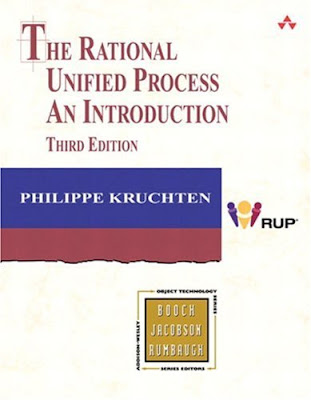
Publisher : Addison Wesley
Pub Date : December 19, 2003
ISBN : 0-321-19770-4
Pages : 336
Copyright
The Addison-Wesley Object Technology Series
The Component Software Series
Preface
Goals of This Book
Who Should Read This Book?
How to Use This Book
Organization and Special Features
For More Information
Second Edition
Third Edition
Acknowledgments
Part I. The Process
Chapter 1. Software Development Best Practices
The Value of Software
Symptoms and Root Causes of Software Development Problems
Software Best Practices
Develop Software Iteratively
Manage Requirements
Use Component-Based Architectures
Visually Model Software
Continuously Verify Software Quality
Control Changes to Software
The Rational Unified Process
Summary
Chapter 2. The Rational Unified Process
What Is the Rational Unified Process?
The Rational Unified Process as a Product
Software Best Practices in the Rational Unified Process
Other Key Features of the Rational Unified Process
A Brief History of the Rational Unified Process
Summary
Chapter 3. Static Structure: Process Description
A Model of the Rational Unified Process
Roles
Activities
Artifacts
Disciplines
Workflows
Additional Process Elements
A Process Framework
Summary
Chapter 4. Dynamic Structure: Iterative Development
The Sequential Process
Overcoming Difficulties: Iterate!
Gaining Control: Phases and Milestones
A Shifting Focus across the Cycle
Phases Revisited
Benefits of an Iterative Approach
Summary
Chapter 5. An Architecture-Centric Process
The Impotance of Models
Architecture
The Impotance of Architecture
A Definition of Architecture
Architecture Representation
An Architecture-Centric Process
The Purpose of Architecture
Component-Based Development
Other Architectural Concepts
Summary
Chapter 6. A Use-Case-Driven Process
Definitions
Identifying Use Cases
Evolving Use Cases
Organizing Use Cases
Use Cases in the Process
Summary
Part II. Process Disciplines
Chapter 7. The Project Management Discipline
Purpose
Planning an Iterative Project
The Concept of Risk
The Concept of Measurement
Roles and Artifacts
Workflow
Building an Iteration Plan
Summary
Chapter 8. The Business Modeling Discipline
Purpose
Why Business Modeling?
Using Software Engineering Techniques for Business Modeling
Business Modeling Scenarios
Roles and Artifacts
Workflow
From the Business Models to the Systems
Modeling the Software Development Business
Tool Support
Summary
Chapter 9. The Requirements Discipline
Purpose
What Is a Requirement?
Types of Requirements
Capturing and Managing Requirements
Requirements Workflow
Roles in Requirements
Artifacts Used in Requirements
Tool Support
Summary
Chapter 10. The Analysis and Design Discipline
Purpose
Analysis versus Design
How Far Must Design Go?
Roles and Artifacts
Designing a User-Centered Interface
The Design Model
The Analysis Model
The Role of Interfaces
Artifacts for Real-Time Systems
Component-Based Design
Workflow
Tool Support
Summary
Chapter 11. The Implementation Discipline
Purpose
Builds
Integration
Prototypes
Roles and Artifacts
Workflow
Tool Support
Summary
Chapter 12. The Test Discipline
Purpose
Testing in the Iterative Lifecycle
Dimensions of Testing
Roles and Artifacts
Workflow
Tool Support
Summary
Chapter 13. The Configuration and Change Management Discipline
Purpose
The CCM Cube
Roles and Artifacts
Workflow
Tool Support
Summary
Chapter 14. The Environment Discipline
Purpose
Roles and Artifacts
Workflow
Tool Support
Summary
Chapter 15. The Deployment Discipline
Purpose
Roles and Artifacts
Workflow
Summary
Chapter 16. Typical Iteration Plans
Defining the Product Vision and the Business Case
Building an Architectural Prototype
Implementing the System
Summary
Chapter 17. Implementing the Rational Unified Process
Introduction
The Effect of Implementing a Process
Implementing the Rational Unified Process Step by Step
Implementing a Process Is a Project
Summary
Appendix A. Summary of Roles
The Analyst Roles
The Developer Roles
The Manager Roles
The Tester Roles
The Production and Support Roles
Additional Roles
Appendix B. Summary of Artifacts
Business Modeling Artifact Set
Requirements Artifact Set
Analysis and Design Artifact Set
Implementation Artifact Set
Test Artifact Set
Deployment Artifact Set
Configuration and Change Management Artifact Set
Project Management Artifact Set
Environment Artifact Set
Appendix C. Acronyms
Glossary
Bibliography
General
Software Development Process
Object-Oriented Technology
Modeling and the Unified Modeling Language
Project Management
Requirements Management
Configuration Management
Testing and Quality
Software Architecture
Business Engineering
Others
Download
Another Software Engineering books
No comments:
Post a Comment